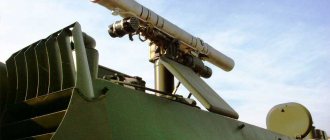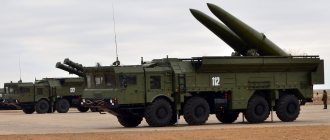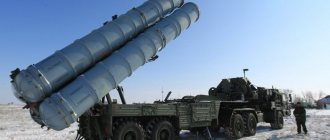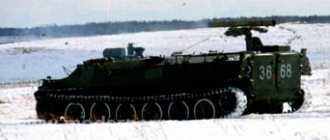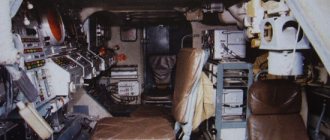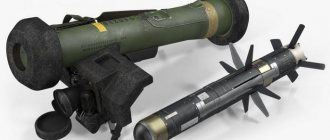Missile system M142 HIMARS (USA). Characteristics and impact on the environment
Joint exercises of NATO forces Saber Strike 2016 continue. As part of this event, military personnel of several countries of the North Atlantic Alliance are engaged in training interactions and solving assigned combat training tasks in training grounds on the territory of a number of Eastern European states. A large number of soldiers and officers, as well as various military equipment belonging to different countries, were involved in the maneuvers. Two units of combat vehicles delivered to Eastern Europe attracted the attention of the press abroad and in our country. On June 14, a C-17 Globemaster III military transport aircraft from the 164th Airlift Wing of the Tennessee National Guard landed at Tallinn Airport (Estonia). On board the aircraft were two M142 HIMARS combat vehicles. This equipment, also belonging to the National Guard, was delivered to the Baltic States to participate in the ongoing exercise Saber Strike 2016. As part of the exercise, the missile systems were supposed to go to one of the training grounds, which became a platform for maneuvers, and then attack conditional targets.
The transfer of missile systems attracted the attention of the foreign and domestic press. Thus, some foreign publications called the participation of two HIMARS systems in the Baltic exercises “an unambiguous signal to Moscow.” Pentagon officials, in turn, avoided such bold and even provocative statements. According to official data, missile systems are involved in exercises to test the interaction of armies of several countries and to gain experience working at new test sites.
M142 HIMARS firing. Photo: Wikimedia Commons
Reviews from the foreign press about the M142 HIMARS complexes and their capabilities, as well as the political consequences of the transfer of such equipment, cannot but attract attention. Let's look at these systems and try to determine what threat they could pose to Russia if deployed in Eastern European countries.
The first work on the topic HIMARS (High-Mobility Artillery Rocket System) was carried out back in the eighties. The M270 MLRS MLRS that existed at that time met the requirements in its main characteristics, but its mobility may have been insufficient to solve some problems. As a result, it was necessary to create a new similar system in a more mobile version. By the early nineties, the possibility of creating a relatively compact launcher with six guides for 227-mm rockets, which could be placed on an air transportable chassis, was determined.
In mid-1990, the Pentagon formed requirements for a new multiple launch rocket system, characterized by high mobility and mobility. A few years later, a prototype of the HIMARS system was tested, which, however, was noticeably different from subsequent production vehicles. At the beginning of 1996, Lockheed Martin received a contract to complete the design work and build several full-fledged prototypes of the new system. Fulfillment of the terms of this contract made it possible to complete the project and prepare new combat vehicles for mass production. After a series of necessary tests, in 2003, the M142 HIMARS complex was put into service. It should be noted that adoption did not lead to the stoppage of various works. The creation of new ammunition for the missile system has been going on for a long time and has not stopped yet.
When developing the new HIMARS project, the main task was to ensure high mobility of equipment on the battlefield, as well as simplify the transfer of military transport aircraft. Such requirements led to the choice of one of the available serial wheeled chassis. In addition, it was decided to rework the existing launcher with a halving of ammunition. As a result, the missile system retained some basic characteristics and also improved some other parameters.
Two combat vehicles in the cockpit of a military transport aircraft. Photo Army.mil
The basis for the M142 HIMARS combat vehicle is a three-axle all-wheel drive chassis of the FMTV family with a payload capacity of 5 tons. The base vehicle is built using a cabover layout and receives a set of necessary units. Thus, serial equipment can receive both standard and protected crew cabins. A block of additional equipment is mounted behind the cab on the chassis, and the loading area of the frame is given over to the placement of a slewing bearing with a launcher.
The total length of the vehicle is 7 m, width 2.4 m, height (in stowed position) - 3.2 m. The combat weight of a self-propelled launcher with ammunition reaches 10.9 tons. The vehicle is capable of reaching speeds of up to 85 km/h and traveling at one refueling up to 480 km. The complex is controlled by a crew of three located inside the cabin. According to the development company, if necessary, all operations to control the combat vehicle can be performed by one person.
At the rear of the chassis there is a rotary support device with drives for horizontal and vertical guidance. It is possible to fire in any direction with elevation angles from -2° to +60°. The aiming drives are controlled from a remote control located in the cockpit. The fire control systems of the M142 HIMARS complex are unified with the equipment of the MLRS complex.
The M142 launcher was developed taking into account developments in the MLRS system, and also uses some of its components. The installation is a U-shaped device with fastenings for replaceable guide packages. In addition, a reloading system tap is placed on the top of the launcher. This launcher design allows the HIMARS complex to use standard transport and launch containers created for the M270 MLRS.
Unloading equipment in Estonia. Photo Army.mil
The container is a block of several (6 in the standard version) fiberglass transport and launch containers of a tubular design with guides for imparting rotation to the missiles. The containers are connected to each other by several frames, which allows simultaneous operations with the entire package. Ammunition is placed into containers at the factory and sealed caps are installed. Removal or other maintenance of missiles before firing is not provided.
To reload, the launcher rotates backwards in the direction of travel, after which the supporting frame of the lifting device extends from its upper part. Using a set of cables and hooks, a package of containers is lifted from the ground or from the cargo platform of a transport vehicle, after which it is placed inside the launcher. Dismantling the used bag is carried out in the same way.
An important feature of the MLRS and HIMARS multiple launch rocket systems is a wide range of compatible ammunition. Due to the absence of its own launch guides, the vehicle can carry containers with missiles of various types and different calibers. Thanks to this, the self-propelled launcher can carry from one to six missiles with different characteristics.
As a simplified and lightweight version of the M270 MLRS, the M142 HIMARS system retains the ability to use existing ammunition. In addition, new types of missiles have been unified. Products borrowed from an existing project are often referred to as MFOM (MLRS Family of Munitions). This family includes both unmanaged and managed systems. All projectiles of the MFOM family have a caliber of 227 mm and a length of 3.94 m, but differ in weight and combat load. Regardless of missile types, the HIMARS launcher can carry six rounds of ammunition.
HIMARS with protected cabin. Photo: Lockheedmartin.com
The following missiles have been developed for MLRS and HIMARS: - M26 and its modifications. They are equipped with cumulative fragmentation ammunition in quantities from 518 to 644 pieces. The flight range, depending on the modification, is from 32 to 45 km; — M30. A projectile with 404 submunitions and a combined control system based on inertial and satellite navigation. Capable of flying 84 km; — M31. Modification of the M30 product with a high-explosive fragmentation warhead weighing 90 kg. Other characteristics do not change.
A number of new missiles compatible with the M270 and M142 have also been developed by several foreign countries. They are designed to solve various problems and have different characteristics.
If necessary, multiple launch rocket systems can be used as operational-tactical missile systems. In this case, guides with AFOM series missiles (Army TACMS Family of Munitions - ATACMS Army Family of Munitions) must be mounted on the launcher. Products in this line, also known as M39 or MGM-140, are unguided and guided missiles with different payloads and different ranges. The following missiles are in service: - MGM-140A. Unguided missile with a flight range of 128 km. Combat load in the form of 950 high-explosive fragmentation submunitions; — MGM-140B. A missile with a range of 165 km and a combined inertial-satellite control system. Carries 275 high-explosive fragmentation ammunition; — MGM-140E. At the moment, the most advanced development of the family, characterized by a flight range of up to 270 km. A control system is used. A 227 kg high-explosive fragmentation warhead is delivered to the target.
After the adoption of the M142 HIMARS complex into service, the development of ammunition for it did not stop. For this reason, the development of new missiles for one purpose or another continues to this day. The main focus is on the development of the MGM-140 ATACMS missiles. Such weapons make it possible to solve problems that are inaccessible to the MFOM family of ammunition, which causes increased interest on the part of the customer. Attempts were also made to modify the complex for the use of existing and promising anti-aircraft missiles.
Recharging process. The lifting device is extended and the package of containers is being prepared for loading. Photo Rbase.new-factoria.ru
After carrying out all the necessary tests, the new M142 HIMARS complexes went into production. By the mid-2000s, this equipment entered the army, after which its development began. Subsequently, several new contracts were signed to supply HIMARS systems to the Army, Marine Corps and National Guard. To date, American artillerymen from various structures have received a total of 417 missile systems and a significant amount of ammunition of all compatible types.
Over time, some of the serial equipment was sent to hot spots. Thus, in February 2010, one of the units, armed with the M142, took part in hostilities for the first time. During one of the operations in Afghanistan, two missile launches were carried out. The products seriously deviated from the required trajectory, as a result of which they fell away from the selected target and led to the death of several civilians. Operation of the HIMARS systems was suspended until the investigation was completed. Subsequently, the problems were resolved, which made it possible to return the complexes to operation.
Since November 2015, HIMARS systems sent to Iraq have been participating in the fight against terrorists. Over the past period, several hundred missile launches of various types have been carried out against various enemy targets. Due to the continued unfavorable situation in the region, it should be expected that the operation of these systems will continue for a long time, and the total consumption of ammunition will increase many times over in comparison with existing indicators.
A few days ago, two M142 HIMARS combat vehicles of the Tennessee National Guard were transferred to Estonia to participate in the joint NATO exercise Saber Strike 2016. During this event, the crews of the complexes successfully completed the assigned tasks, transferring to the required training ground and then firing at training targets.
Control panel installed in the cabin. Photo Rbase.new-factoria.ru
A number of foreign media outlets called the transfer of HIMARS systems to the Baltic states “a signal for Moscow.” Recently, relations between Russia and NATO have become strained, and regular exercises in Eastern Europe, at a minimum distance from Russian borders, only worsen the situation. In addition, unfriendly publications in the foreign press do not help to improve relations.
It should be noted that the authors of the “signal” version are right to a certain extent. The transfer of multiple launch rocket systems can indeed be regarded as an aggressive step that in no way contributes to defusing the situation. Given the possibility of attacking targets at distances from 30 to 270 km, such complexes can pose a danger to border facilities. The existence of a wide range of warheads and the relatively high accuracy of guided ammunition only increases the risks and also makes the threat more serious.
The latest American missile systems should be considered with Russian developments of a similar purpose. First of all, the HIMARS system makes us remember the 9K58 Smerch MLRS. Combat vehicles of this type are capable of firing a salvo of 12 300 mm caliber shells. Depending on the type of ammunition used, targets can be hit at ranges of up to 70-90 km. Warheads of various types, both unitary and cluster with different submunitions, are delivered to targets.
The Tornado-S modernization project is also being implemented, within the framework of which the complex’s control system is being updated, and new ammunition is being created. The missiles are capable of flying at a range of up to 120 km while maintaining combat qualities at the level of existing missiles.
The M270 MLRS fires a missile from the ATACMS family. Photo by Wikimedoa Commons
The M142 HIMARS combat vehicle can be used not only as a multiple launch rocket system, but also as an operational-tactical missile system. In this case, the Tochka-U and Iskander systems can be considered Russian analogues of the complex. Depending on the type of missile, the Tochka-U complex is capable of hitting targets at ranges of up to 120 km, and Iskander – up to 500 km. Various missile warheads are also proposed.
There are concerns that M142 HIMARS systems could be deployed in Eastern Europe on a permanent basis. In this case, some kind of response to new threats will be needed. It is noteworthy that one of the options for such an answer already exists. Previously, information appeared in foreign and domestic sources about the transfer of Iskander complexes to the Kaliningrad region. In addition, such transport tasks were repeatedly practiced during the exercises. By deploying such systems in the western regions of the country, including the Kaliningrad region, it is possible to hit targets in a large part of Eastern Europe.
The totality of the characteristics of the M142 HIMARS missile systems, as well as the characteristic features of the systems themselves and their ammunition, make us consider such equipment to be a fairly serious threat that requires a response. Whether such equipment will remain in the Baltic states, or will return to the United States after the completion of current exercises, is still unknown. However, such risks must be taken into account now and plans made accordingly. Time will tell how the situation will develop further.
Based on materials from the sites: https://army.mil/ https://lockheedmartin.com/ https://tvzvezda.ru/ https://rg.ru/ https://rbase.new-factoria.ru/ https: //globalsecurity.org/
Prerequisites for creation
The main reason why the US armed forces thought about creating such a complex was the need to arm marine units, paratroopers and rapid reaction forces with mobile launchers that could be airlifted to almost any point.
In the mid-80s, Loral Vought Systems began to explore the prospect of developing a six-barrel TPK (transport and launch container) for 227-caliber missiles and mounting it on tracked and wheeled chassis. The program to create a high mobility artillery system also aimed at the prospect of air transportation of the system using the C-130 military aircraft. Operation Just Cause, which took place in late 1989 in Panama, clearly illustrated the need for the development of HIMARS.
Reloading and fire control
The reloading mechanism (RMM) is made in the form of a retractable console equipped with an electric winch. The mechanism can be controlled both from the driver’s cab and via a remote control. The second option is especially convenient, as it is clearer. To load the TPK into the PZM clip, the latter is placed in a horizontal position, and its console extends. Using a crane, the container is lifted and placed in place. The winch is attached to the center of gravity of the container.
The fire control system, as well as the electronics units and communication devices, are designed in the same way as in the older MLRS BM. However, today a modernized version of the machine has been developed, the control panel of which has improved interfaces. The word interfaces in this context means operational blocks and elements.
Development
In the summer of 1990, the US Army began drawing up requirements for a lightweight rocket system based on a truck chassis. The demonstration of the prototype took place in September 1994. And a year and a half later, the US Guided Weapons Command signed a contract with Fire Control and Lockheed Martin Missiles for the assembly of HIMARS MLRS vehicles. The contract value was $22.3 billion.
According to the terms of the contract, the company's specialists assembled four experimental combat vehicles. Three of them were transferred to the customer for two-year tests, and the fourth was left for testing by the developer. In the summer of 1998, American ground forces experts successfully conducted shooting tests of the ATACMS missile based on a prototype HIMARS MLRS vehicle.
Russian analogues
Mobile rocket artillery is also available in Russia. It is represented by the Tornado MLRS family. There are two types - “Grad” and “Smerch”. The caliber of the Grad system is 122 mm. It consists of a modernized combat vehicle, an automated control system and unguided projectiles. Let’s say this is the younger version of “Tornado”.
The Smerch MLRS is more similar to the American HIMARS system. The caliber of the projectiles is already 300 mm, and the maximum flight range is 130 km. "Smerch" launches unguided and adjustable rockets. In the future, it is possible to increase the flight range in the Tornado system. The Smerch MLRS also consists of a modernized vehicle with an automatic guidance system.
Transport-charging machine
As for the transport-charging vehicle, it is a truck with an on-board crane and a trailer. Like the combat vehicle, it has a 6x6 wheel arrangement. The crane is located at the rear of the truck. With its help, the operator reloads transport and launch containers. A trailer is needed to transport an additional TPK.
The combat vehicle can be transported on the C-130 Hercules transport aircraft. After unloading from it, it is brought into full readiness in no more than 10 minutes. The HIMARS class missile technology is very mobile, so after completing a combat mission, it quickly leaves the firing line. At the moment, an option is being developed to install the artillery part of the HIMARS system on a modified vehicle chassis with a carrying capacity of 7 tons.
Some more interesting characteristics:
- Machine dimensions: length – 6949, width – 2400, height – 3180 mm.
- Weight of the combat vehicle without shells: 13696 kg. With shells - about 16,000 kg. The chassis weighs 8273, and the module with container weighs 2915 kg.
- The maximum speed of a charged car is 89 km/h. Without ammunition, the speed is 5 km/h higher.
- The maximum slope that the machine can overcome is 60 degrees.
- The horizontal firing angle is 280 degrees.
R44 rocket
In the 2000s, Lockheed Martin developed a prototype of the P44 missile, which was designed to accurately hit moving targets from long distances, as part of the MLRS and HIMARS combat systems. To launch it, they developed a special container that can hold 10 missiles. The prototype could work both with the help of GPS, in auxiliary inertial guidance mode, to hit stationary targets, and with a homing head for moving targets. In the second case, the missile was equipped according to the principle of a single multi-purpose JCM missile.
The prototype had a homing head operating in three modes:
- Doppler radar. Operates in the millimeter wave range. Can be used in any weather conditions. Hit moving targets.
- Cooled infrared. Identifies and categorizes targets.
- Semi-active laser. Hit targets using additional target designation.
A 177 mm model was chosen as a starting accelerator, which is characterized by its low price and the possibility of further refinement. The design of the prototype used an enlarged warhead from the Hellfire II missile or a cumulative warhead, characterized by the presence of a shaping device. In the future, it was assumed that it would be possible to increase the length and mass of the rocket.
In March 2007, information appeared that the rocket had successfully passed wind tunnel tests, static burning of the rocket engine, and flight tests at the White Sands test site in New Mexico. A month later it became known that the second stage of testing was no less successful. During a series of tests of prototypes of the P44 missile, the HIMARS combat vehicle was used, for which these missiles are intended.
Car
The combat vehicle is a modernized version of the 5-ton Stewart & Stevenson truck with a 6x6 wheel arrangement. The diesel, 6.6-liter, 6-cylinder gas turbine engine from Caterpillar develops 290 horsepower. The fuel tank has a capacity of 56 gallons. The power reserve is 480 km. The engine works in tandem with an automatic (if you thought it was automatic) gearbox with seven ranges. The suspension is parabolic with leaf springs. The vehicle's ground clearance is 564 mm. The truck can storm water obstacles up to 900 mm deep. The crew consists of three people: driver, gunner, commander. In extreme conditions, the task can be completed by one person.
Rocketry
Rocket technology does not have a permanent package of guides. Unified disposable TPKs from the MLRS system machine are used as guides. The HIMARS launcher can fire any guided and unguided missiles of the MLRS system, as well as missiles of the MGM-140 and MGM-164 models of the ATACMS complex. When the last tactical missile is launched, the spent transport and launch containers are simply replaced with charged ones. Charging and sealing of the TPK occurs in the factory. Standard TPKs weigh a little over two tons and consist of 6 fiberglass pipes held together with an aluminum clip. To impart rotation to the projectile when fired, at a frequency of 10-12 revolutions per minute, there are spiral slides inside the guides. A tactical missile is launched directly from a disposable container. In such TPKs, the missile can be stored for at least 10 years, maintaining its combat readiness.




